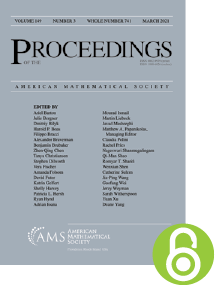The equivariant Ehrhart theory of the permutahedron
HTML articles powered by AMS MathViewer
- by Federico Ardila, Mariel Supina and Andrés R. Vindas-Meléndez PDF
- Proc. Amer. Math. Soc. 148 (2020), 5091-5107 Request permission
Abstract:
Equivariant Ehrhart theory enumerates the lattice points in a polytope with respect to a group action. Answering a question of Stapledon, we describe the equivariant Ehrhart theory of the permutahedron, and we prove his Effectiveness Conjecture in this special case.References
- Federico Ardila, Matthias Beck, and Jodi McWhirter, Ehrhart quasipolynomials of Coxeter permutahedra, arXiv:2004.02952, Rev. Acad. Colombiana Ci. Exact. Fis. Nat., to appear.
- Federico Ardila, Anna Schindler, and Andrés R. Vindas-Meléndez, The equivariant volumes of the permutahedron, Discrete and Computational Geometry (2019), 1–18.
- Welleda Baldoni and Michèle Vergne, Kostant partitions functions and flow polytopes, Transform. Groups 13 (2008), no. 3-4, 447–469. MR 2452600, DOI 10.1007/s00031-008-9019-8
- Matthias Beck and Sinai Robins, Computing the continuous discretely, Undergraduate Texts in Mathematics, Springer, New York, 2007. Integer-point enumeration in polyhedra. MR 2271992
- David A. Cox, John B. Little, and Henry K. Schenck, Toric varieties, Graduate Studies in Mathematics, vol. 124, American Mathematical Society, Providence, RI, 2011. MR 2810322, DOI 10.1090/gsm/124
- Igor Dolgachev and Valery Lunts, A character formula for the representation of a Weyl group in the cohomology of the associated toric variety, J. Algebra 168 (1994), no. 3, 741–772. MR 1293622, DOI 10.1006/jabr.1994.1251
- Eugène Ehrhart, Sur les polyèdres rationnels homothétiques à $n$ dimensions, C. R. Acad. Sci. Paris 254 (1962), 616–618 (French). MR 130860
- William Fulton, Introduction to toric varieties, Annals of Mathematics Studies, vol. 131, Princeton University Press, Princeton, NJ, 1993. The William H. Roever Lectures in Geometry. MR 1234037, DOI 10.1515/9781400882526
- William Fulton and Joe Harris, Representation theory, Graduate Texts in Mathematics, vol. 129, Springer-Verlag, New York, 1991. A first course; Readings in Mathematics. MR 1153249, DOI 10.1007/978-1-4612-0979-9
- June Huh, Rota’s conjecture and positivity of algebraic cycles in permutohedral varieties, ProQuest LLC, Ann Arbor, MI, 2014. Thesis (Ph.D.)–University of Michigan. MR 3321982
- A. G. Hovanskiĭ, Newton polyhedra, and toroidal varieties, Funkcional. Anal. i Priložen. 11 (1977), no. 4, 56–64, 96 (Russian). MR 0476733
- A. Losev and Y. Manin, New moduli spaces of pointed curves and pencils of flat connections, Michigan Math. J. 48 (2000), 443–472. Dedicated to William Fulton on the occasion of his 60th birthday. MR 1786500, DOI 10.1307/mmj/1030132728
- Jodi McWhirter, Ehrhart quasipolynomials of Coxeter permutahedra, Master’s Thesis, 2019.
- Karola Mészáros and Alejandro H. Morales, Flow polytopes of signed graphs and the Kostant partition function, Int. Math. Res. Not. IMRN 3 (2015), 830–871. MR 3340339, DOI 10.1093/imrn/rnt212
- Robert Morelli, Pick’s theorem and the Todd class of a toric variety, Adv. Math. 100 (1993), no. 2, 183–231. MR 1234309, DOI 10.1006/aima.1993.1033
- N. Perminov and Sh. Shakirov, Discriminants of symmetric polynomials, arXiv e-prints (2009Oct), arXiv:0910.5757, available at 0910.5757.
- James E. Pommersheim, Toric varieties, lattice points and Dedekind sums, Math. Ann. 295 (1993), no. 1, 1–24. MR 1198839, DOI 10.1007/BF01444874
- C. Procesi, The toric variety associated to Weyl chambers, Mots, Lang. Raison. Calc., Hermès, Paris, 1990, pp. 153–161. MR 1252661
- G. C. Shephard, Combinatorial properties of associated zonotopes, Canadian J. Math. 26 (1974), 302–321. MR 362054, DOI 10.4153/CJM-1974-032-5
- Richard P. Stanley, A zonotope associated with graphical degree sequences, Applied geometry and discrete mathematics, DIMACS Ser. Discrete Math. Theoret. Comput. Sci., vol. 4, Amer. Math. Soc., Providence, RI, 1991, pp. 555–570. MR 1116376
- Alan Stapledon, Equivariant Ehrhart theory, Adv. Math. 226 (2011), no. 4, 3622–3654. MR 2764900, DOI 10.1016/j.aim.2010.10.019
- Alan Stapledon, Representations on the cohomology of hypersurfaces and mirror symmetry, Adv. Math. 226 (2011), no. 6, 5268–5297. MR 2775901, DOI 10.1016/j.aim.2011.01.006
- John R. Stembridge, Some permutation representations of Weyl groups associated with the cohomology of toric varieties, Adv. Math. 106 (1994), no. 2, 244–301. MR 1279220, DOI 10.1006/aima.1994.1058
Additional Information
- Federico Ardila
- Affiliation: Department of Mathematics, San Francisco State University, 1600 Holloway Avenue, San Francisco, California 94132; Department of Mathematics, Universidad de Los Andes, Bogota, Columbia
- MR Author ID: 725066
- Email: federico@sfsu.edu
- Mariel Supina
- Affiliation: Department of Mathematics, 970 Evans Hall, University of California, Berkeley, Berkeley, California 94720-3840
- Email: mariel_supina@berkeley.edu
- Andrés R. Vindas-Meléndez
- Affiliation: Department of Mathematics, San Francisco State University, 1600 Holloway Avenue, San Francisco, California 94132; Department of Mathematics, 719 Patterson Office Tower, University of Kentucky, Lexington, Kentucky 40506-0027
- MR Author ID: 1353509
- ORCID: 0000-0002-7437-3745
- Email: andres.vindas@uky.edu
- Received by editor(s): November 22, 2019
- Received by editor(s) in revised form: March 6, 2020
- Published electronically: September 17, 2020
- Additional Notes: This work was completed while the first author was a Spring 2019 Visiting Professor at the Simons Institute for Theoretical Computer Science in Berkeley, and a 2019–2020 Simons Fellow while on sabbatical in Bogotá.
The authors were supported by NSF Award DMS-1600609 and DMS-1855610 and Simons Fellowship 613384 (FA), the Graduate Fellowships for STEM Diversity (MS), and NSF Graduate Research Fellowship DGE-1247392 (ARVM) - Communicated by: Patricia L Hersh
- © Copyright 2020 American Mathematical Society
- Journal: Proc. Amer. Math. Soc. 148 (2020), 5091-5107
- MSC (2010): Primary 14L30, 14M25, 52B15, 52B20, 05E18
- DOI: https://doi.org/10.1090/proc/15113
- MathSciNet review: 4163825


